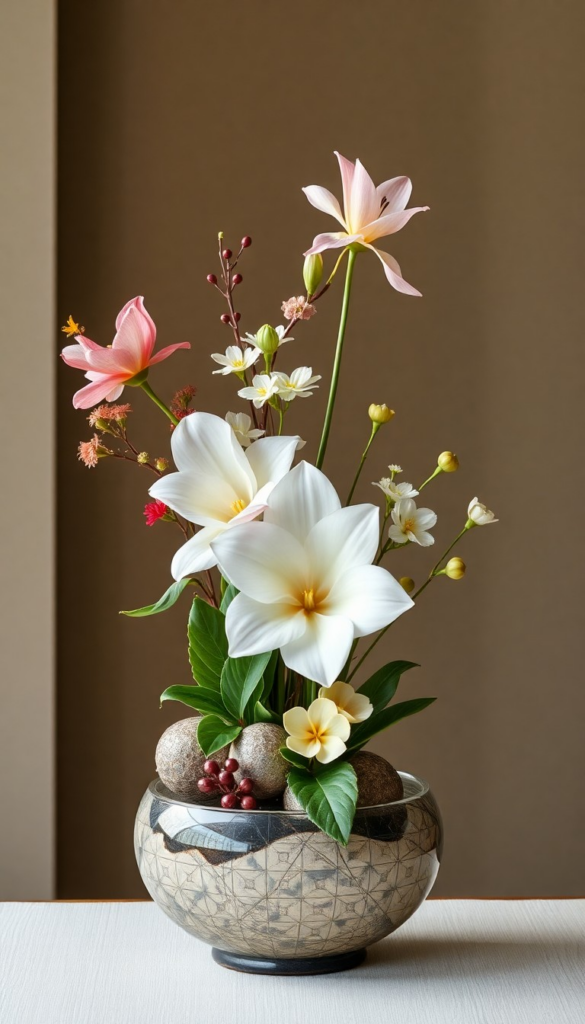28 Ikebana Flower Arrangement Ideas

Ikebana, the traditional Japanese art of flower arrangement, is not just about placing flowers in a vase. It is a form of creative expression that embodies harmony, balance, and simplicity.
As an avid Ikebana enthusiast, I have curated a list of 28 unique flower arrangement ideas to inspire you to create your own stunning masterpieces.
From minimalist designs to extravagant displays, there is something for everyone to enjoy in this list.
Ohara Style Ikebana:

Ohara Style Ikebana is known for its naturalistic approach to flower arranging. The arrangements often feature long, flowing lines and a sense of movement. To create an Ohara Style arrangement, start by selecting a tall vase and using a variety of different flowers and foliage to create depth and dimension.
Moribana Style Ikebana:

Moribana Style Ikebana is characterized by its low, shallow containers and compact arrangements. This style is perfect for small spaces or as a centerpiece on a dining table. To create a Moribana Style arrangement, use a kenzan (frog) to hold the flowers in place and play with different heights and textures.
Nageire Style Ikebana:

Nageire Style Ikebana is a more freeform style of flower arranging that involves simply throwing the flowers into the vase. This style is all about spontaneity and embracing the natural beauty of the flowers. To create a Nageire Style arrangement, choose a tall, narrow vase and let the flowers fall where they may.
Rikka Style Ikebana:

Rikka Style Ikebana is the oldest and most formal style of Ikebana, dating back to the 15th century. This style often features tall, vertical arrangements that represent mountains, waterfalls, and other natural elements. To create a Rikka Style arrangement, use a tall, cylindrical vase and carefully arrange the flowers in a symmetrical pattern.
Shoka Style Ikebana:

Shoka Style Ikebana is a more modern and simplified version of Rikka Style Ikebana. This style focuses on using a minimal number of flowers to create a harmonious and balanced arrangement. To create a Shoka Style arrangement, use a tall, narrow vase and arrange the flowers in a triangular pattern.
Jiyuka Style Ikebana:

Jiyuka Style Ikebana is a freestyle form of flower arranging that allows for more creativity and artistic expression. This style is all about breaking the rules and letting your imagination run wild. To create a Jiyuka Style arrangement, use unconventional materials like branches, leaves, and even rocks to create a unique and eye-catching display.
Seika Style Ikebana:

Seika Style Ikebana is a minimalist style of flower arranging that focuses on the beauty of simplicity. This style often features a single flower or branch displayed in a clean and uncluttered way. To create a Seika Style arrangement, use a simple vase or container and let the beauty of the flower speak for itself.
Nageirebana Style Ikebana:

Nageirebana Style Ikebana is a more modern and experimental style of flower arranging that involves throwing the flowers into the vase in a more controlled manner. This style is all about embracing imperfection and letting the flowers take on a natural and organic form. To create a Nageirebana Style arrangement, use a wide, shallow vase and let the flowers cascade over the edges in a beautiful and chaotic way.
Morimono Style Ikebana:

Morimono Style Ikebana is a playful and whimsical style of flower arranging that involves using unconventional materials like fruits, vegetables, and other objects. This style is all about innovation and creativity, and is perfect for those looking to think outside the box. To create a Morimono Style arrangement, gather a variety of different objects and arrange them in a visually interesting way.
Shoka Shimputai Style Ikebana:

Shoka Shimputai Style Ikebana is a more contemporary and simplified version of Shoka Style Ikebana. This style is characterized by its use of a single main flower or branch, accompanied by a few secondary flowers or branches. To create a Shoka Shimputai Style arrangement, use a tall, narrow vase and arrange the flowers in a harmonious and balanced way.
Rikka Shimputai Style Ikebana:

Rikka Shimputai Style Ikebana is a more modern and simplified version of Rikka Style Ikebana. This style is characterized by its use of a tall, vertical arrangement that represents the natural elements of heaven and earth. To create a Rikka Shimputai Style arrangement, use a tall, cylindrical vase and carefully arrange the flowers in a symmetrical and balanced pattern.
Jiyuubana Style Ikebana:

Jiyuubana Style Ikebana is a more experimental and unconventional style of flower arranging that allows for more freedom and creativity. This style is all about pushing the boundaries of traditional Ikebana and creating something truly unique and original. To create a Jiyuubana Style arrangement, use a variety of different materials and let your imagination run wild.
Seishuubana Style Ikebana:

Seishuubana Style Ikebana is a more formal and structured style of flower arranging that focuses on using a specific set of rules and techniques. This style is perfect for those looking to hone their skills and create more traditional and classical arrangements. To create a Seishuubana Style arrangement, use a symmetrical and balanced design and pay close attention to detail.
Conclusion:
In conclusion, Ikebana is a beautiful and intricate art form that allows for endless creativity and expression.
Whether you prefer the traditional styles of Rikka and Shoka, or the more modern and experimental styles of Jiyuka and Morimono, there is something for everyone to enjoy in the world of Ikebana.
I hope this list of 28 Ikebana flower arrangement ideas has inspired you to pick up some flowers and create your own stunning masterpiece. Remember, the key to Ikebana is to embrace simplicity, harmony, and balance, and let your creativity shine through in every arrangement you create. Happy arranging!






